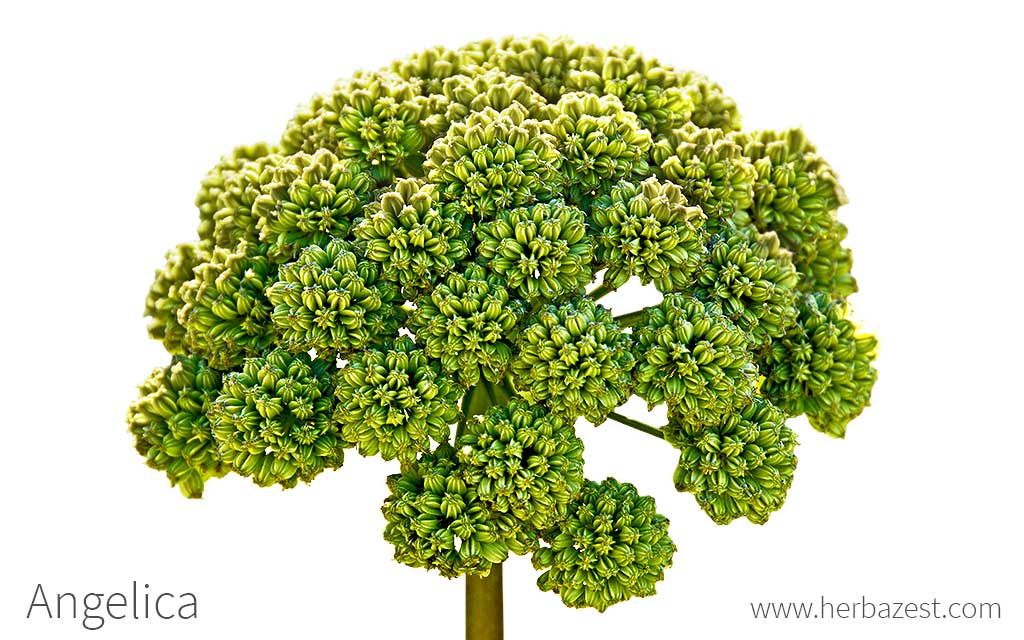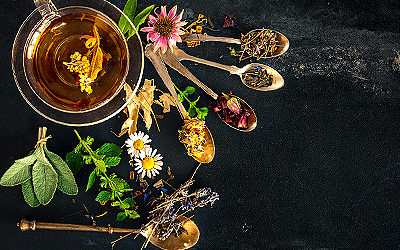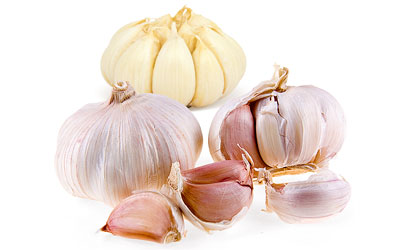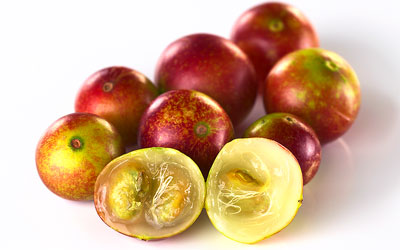Angelica archangelica - also known as archangel, European angelica, garden angelica, and wild parsnip - originated in Eurasia and now grows wild in Northern Europe, including the Faroe Islands, Iceland, and Greenland. Angelica was thought to have "angelic" healing powers and was traditionally used as a carminative, expectorant, stimulant, stomachic, and tonic, among others. Today, the use of angelica has expanded to ornamental and culinary applications aside from its remedial uses.
Angelica Medicinal Properties
- Medicinal action Carminative, Diuretic
- Key constituents Flavonoids, coumarin, terpenes
- Ways to use Capsules, Decoctions, Hot infusions/tisanes, Tincture, Powder, Ointment, Essential oil
- Medicinal rating (1) Very minor uses
- Safety ranking Use with caution
Health Benefits of Angelica
Angelica has been used as a long-established remedy for a variety of maladies, including nervous headaches, fever, skin rashes, wounds, rheumatism, and toothaches, among others.
Some traditional uses of the herb have been analyzed by modern science. Studies suggest that angelica can be mainly useful for:
Increasing urine output. The diuretic action of angelica can help eliminate harmful substances from body, thus helping treat and prevent gallstones, as well as kidney stones.
Ameliorating gastrointestinal discomfort. The carminative properties of angelica can help alleviate indigestion, bloating, and flatulence, and its bitter taste is useful to stimulate appetite.
Additionally, because of its anti-inflammatory properties, angelica is commonly used to relieve arthritic pain and swelling.
How It Works
Angelica contains bitter agents, essential oil, flavonoids, coumarins, and terpenes that contribute to the vast majority of its medicinal health benefits.
The terpenes are volatile compounds found in angelica'sessential oil - mainly α-pinene, β-pinene, δ-3-carene, limonene, α-phellandrene, β-phellandrene, and p-cymene - and have shown anti-inflammatory and antispasmodic effects. Additionally, their carminative action helps relieve flatulence and other digestive problems, and their antimicrobial effects aid in the treatment of upper respiratory infections.1
Coumarin not only gives angelica flowers their characteristic sweet scent, but it also has clinical value as a precursor for several anticoagulants, notably warfarin.
The oil extracted from the fruits and roots of angelica is rich in coumarin, a phytochemical compound with diaphoretic and diuretic properties.2
More importantly, coumarin's anticoagulant effects are expressed by inhibiting vitamin K dependent clotting factors synthesis, including anticoagulant
proteins.3,4
The diaphoretic action of coumarin also encourages perspiration, which not only helps reduce fever, but also aids the body in getting rid of toxins and bacteria through urine.
Moreover, angelica contains high amounts of flavonoids, which are antioxidants that prevent free radicals damage to tissues, ultimately supporting cardiovascular health and relieving inflammation.5
The combined action of terpenes and flavonoids helps assuage cramps and stomach pains, thus suggesting the use of angelica for premenstrual syndrome (PMS) and menopause symptoms.
Diuretic properties can also be found in herbs like asparagus, celery, and sweet birch, while anise, chamomile, and cloves provide similar carminative effects.
Angelica Side Effects
Angelica is generally recognized as safe for human consumption. However, the plant contains furocoumarins, which increase skin photosensitivity. After consuming or using angelica, it is advised to wear sunblock outside, especially for light-skinned individuals.
Angelica Cautions
There is not enough information to know if angelica is safe when taken by mouth in normal medicinal amounts, and it seems to be harmless for most adults when used topically. However, when used in large doses, angelica may has troublesome effects on cardiovascular function, coagulation, blood pressure, and respiration.
Because it is an emmenagogue - meaning it is used to cause uterine contractions and increase blood flow - angelica may not be safe during pregnancy, as well as for patients scheduled for surgery.
There are no known drug interactions with angelica. However, before consuming the herb for therapeutic purposes, it is recommended to seek medical advice.

How to Consume Angelica
- Edible parts Flowers, Leaves, Root, Seed, Stem
- Edible uses Condiment, Beverage
- Taste Aromatic, Bitter
The medicinal properties of angelica come from all parts - seeds, leaves, stalks, and roots - and have made it a time-honored herb for treating various ailments. However, aside from its therapeutic use, this herb is edible and can be used in a variety of culinary applications.
Angelica's leaf stalks are candied and used in cakes, ice cream, and other desserts.
When chopped, the young leaves and stems can give a mild, fresh taste to salads or be used as a garnish for vegetables and meats. The stalks can be added to milk puddings, custards, and stewed fruits. Angelica combines well with mint, ginger, cinnamon, and vanilla.
Natural Forms
Fresh. The aroma of crushed angelica leaves in a moving vehicle can help prevent motion sickness. Slowly chewing a piece of angelica stalk can also combat flatulence.
Cooked. Angelica leaves can be blanched or boiled. Young flower heads are grilled and served with olive oil and vinegar in some regions of Italy. In this way of consumption, angelica aids digestion thanks to its carminative effects.
Infusion. Angelica tea stimulates appetite, relieves flatulence and muscle spasms, and stimulates kidney function. An infusion of angelica only requires a teaspoon of crushed seeds, which are steeped for five minutes in half a cup of boiling water.
Decoction. After boiling the angelica root in water and letting it steep for five minutes, the liquid can be applied topically to relieve itching and disinfect wounds. When used in a bath, this decoction is soothing to the nerves.
Powder. Up to one teaspoon of powdered angelica, three times daily in fruit juice or water is enough to reap the antipyretic, diaphoretic, digestive, and diuretic effects of the herb.
Herbal Remedies & Supplements
Tincture. All parts of the plant can be macerated in alcohol to obtain a concentrated solution. Two to three drops of angelica tincture diluted in a glass of water can help stimulate appetite while acting as a carminative, antispasmodic, and diuretic.
Essential oil. Angelica oil has soothing qualities that relax nerves and muscles. It can be taken as a supplement or used topically when diluted with vegetable oil. It can also be diffused for up to 30 minutes daily.
Salve. The essential oil of angelica can be used to prepare salves and applied topically to relieve arthritic pains
Capsules. The dried and ground angelica roots can be taken in capsule form to avoid the bitter taste and ensure convenient doses. They help support the digestive system, while calming heartburn, gas, and bloating.
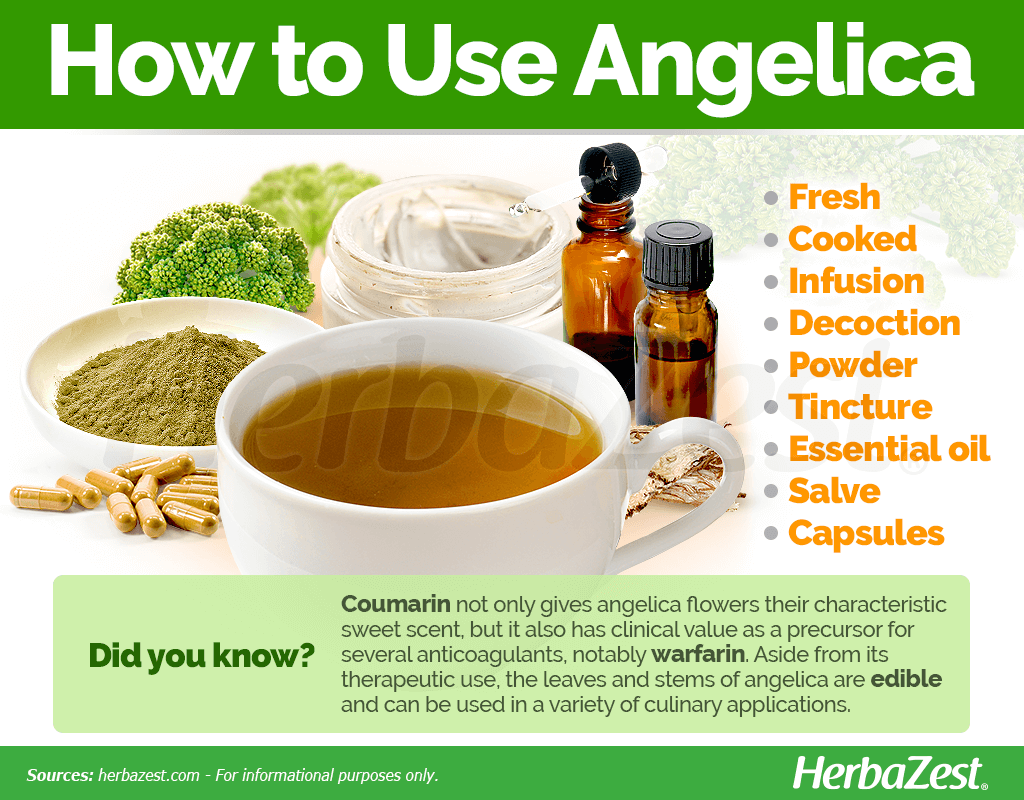
Growing
- Life cycle Biennial
- Harvested parts Flowers, Roots, Seeds, Stem
- Light requirements Partial shade
- Soil Well-drained
- Soil pH 4.5 – 5.0 (Very strongly acidic), 5.1 – 5.5 (Strongly acidic), 5.6 – 6.0 (Moderately acidic), 6.1 – 6.5 (Slightly acidic), 6.6 – 7.3 (Neutral)
- Growing habitat Cool temperate regions
- Planting time Spring
- Plant spacing average 0.9 m (2.95 ft)
- Propagation techniques Divisions
- Potential insect pests Aphids, Mites, Slugs, Leafminers, Snails
- Potential diseases Fungi, Leaf spot, Mildew
Angelica provides an attractive focal point in the garden. Due to its height, the plant is best kept at the back of the garden.
Growing Guidelines
This herb prefers partial shade with deep, well-drained, loam soil that is highly fertile for best growth.
The reported ideal temperature range for angelica is 41 - 66°F (5 - 19°C). A soil with a pH of 4.5 - 7.4 is optimal for growing this herb.
Angelica can be easily propagated by seeds - which are best be sown in the spring - or divisions, in well-composted soil, with a spacing of three feet (90 cm).
With proper shade and moist conditions, seeds take usually 14 - 28 days to germinate.
Although angelica is a hardy plant and can tolerate dry soils, regular watering is necessary to ensure successful germination and growth.
Angelica plants bloom in their second year. Clipping off the flowers will encourage new growth; however, once the plant has set seeds, it begins to die, so it can be removed at this stage. If the seeds look mature, they can be planted immediately in time for the next season.
Some pests that may attack angelica are red spider mites, leaf miners, aphids, slugs, and snails. The plant is also susceptible to leaf spot as well as viral and fungal diseases.
To harvest the angelica plant, it is recommended to cut the stems before midsummer, harvest the leaves before flowering, and collect the ripe seeds in late summer. Roots intended for flavoring agents are often harvested in the fall of the first year. Leaves and stalks are generally harvested in the spring of the second year.
Further information on growing angelica can be found in the herb garden section.
Additional Information
- Other uses Alcohol, Perfume, Soapmaking
Plant Biology
Angelica is a biennial or short-lived perennial. The plant is a thick, aromatic, and fragrant herb that grows to a height of 3.2 - 6.5 feet (1 - 2 m), which includes the flowering head. The plant has compound leaves that are composed of numerous small leaflets, divided into three principal groups; a purplish, hollow stem; and a long, thick, fleshy root. It also has large, globular umbels with small, greenish-white flowers that bloom in July and August. Angelica fruit are pale yellow and oblong.
Classification
All Angelica species are part of the large Apiaceae family, more commonly known as the carrot family, which is comprised of about 434 genera and 3,700 species, mostly temperate herbs with umbellate inflorescences, such as anise (Pimpinella anisum), arracacha (Arracacia xanthorrhiza), carrot (Daucus carota), celery (Apium graveolens), dill (Anethum graveolens), fennel (Foeniculum vulgare), osha (Ligusticum porteri), and parsley (Petroselinum crispum.)
Although there is no general consensus in botanical literature, the genus Angelica is comprised of about 50 species, both biennial and perennial. Its name, derived from the Latin word for "angel," angelus, is a reference to the healing properties of its best-known species, A. archangelica.
Popular Angelica species in North America are A. atropurpurea (Alexanders) and A. lucida (seacoast angelica). Another relative of A. archangelica (also known as "true angelica") is A. sylvestris, or wild angelica, which can be easily mistaken for the real thing, but actually is a different species. It can be distinguished by its flattened inflorescence.
Varieties and Subspecies of Angelica
While there are not known varieties of Angelica, rather than many different species of the same genus, true angelica (A. archangelica) is usually divided into two subspecies, A. archangelica subsp. archangelica, and A. archangelica subsp. litoralis. However, it is very difficult to tell them apart, even for specialists. Subsp. litoralis is a hardy native to Scandinavia and is considered inedible.
Historical Information
Ever since the first settlement of the Faroe Islands and Iceland around the 10th century, angelica was grown for human consumption. Icelandic law books even refer to penalties incurred for the theft of angelica from private gardens, some as serious as being heavily fined.
The herb continued in popularity as a cultivated plant and vegetable in the Faroes, Iceland, and parts of Norway until the early 20th century. Although its culinary application is currently reduced in these countries, some angelica gardens survive as relics of culture traced back to the Viking era.
The most popular Angelica species, also known as true angelica or garden angelica, was dubbed archangelica by Swedish botanist and taxonomist Carl Linnaeus.
Today, it is widely cultivated in Central and Western Europe and is used extensively as a condiment for beverages and in herbal medicine.
Popular Beliefs
Some believe that the popular and fragrant true angelica was coined Archangelica because it usually blooms around the feast day of the Archangel Michael. Others believe it was revealed to the 14th-century physician Mattheus Sylvaticus by the same archangel as a medicinal plant, hence its botanical name Angelica archangelica.
In the Viking's tradition, angelica was widely recognized as symbol of fertility and carried in wedding processions, where the largest one was always in the hands of the bride.
In Iceland, garden angelica was planted in graveyards to keep away septic viruses in corpses, and it can still be seen growing in in Faroese cemeteries. The herb is still believed to be an aphrodisiac.
Economic Data
Garden angelica is cultivated on a large scale in Germany and France for both herbal medicine and various alcohol products. Other countries that cultivate angelica are Belgium, the Netherlands, Poland, Hungary, and Switzerland. Minor commercial production also exists in Iceland. In all these countries, the herb is mainly cultivated for its root.
In 2013, the world's annual production of angelica essential oil was 2,200 pounds (1,000 kg).
Other Uses
Decoration. Dried seed heads of angelica are often used to create flower and vase arrangements.
Aromatherapy. Angelica leaves and stems are chopped and dried and used as potpourri fixatives. The seeds can also be burned to perfume a room.
Personal care. The essential oil of angelica is used in perfumes, aromatherapy, soaps, and shampoos.
Alcoholic beverages. Angelica roots and seeds are traditionally used in alcoholic liqueurs, such as Benedictine, Chartreuse, and gin. Steeping a stalk or leaf adds a subtle flavor to dry white wine before serving.
As a time-honored herb in Icelandic and western European culture, angelica has upheld its reputation throughout the years. Today, the angelica plant is still used, mainly for its diuretic and carminative properties. For anyone in the pursuit of healthier options, angelica is worth considering, not only as a fragrant addition to any garden, but also as an herbal remedy for many health conditions.
Sources
- American Herbal Products Association's Botanical Safety Handbook, Second Edition, pp. 69-70
- Cornell University, Growing Guide, Angelica
- Culinary Herbs, p. 160
- Encyclopedia of Cultivated Plants: From Acacia to Zinnia, pp. 431-434
- Indian Journal of Pharmaceutical Sciences, Evaluation of Antiseizure Activity of Essential Oil from Roots of Angelica archangelica Linn. in Mice, 2010
- International Journal of Pharmaceutical Sciences and Research, Flavonoids: Therapeutic Potential of Natural Pharmacological Agents, 2016
- Journal of Pharmaceutical Research and Health Care, Screening of Synthetic New Heterocyclic Derivatives of 3-Formyl-4-Hydroxycoumarin for Anti-Inflammatory Activity in Albino Rats, 2009
- Margaret Roberts' A-Z Herbs, p. 15
- Medical Astrology
- Medical Herbalism: The Science and Practice of Herbal Medicine, pp. 502-503
- Mediterranean Vegetables, p. 6
- PubChem, Coumarin
- Purdue University, Angelica
- University of Hawaii, Apiaceae (Umbelliferae)
- Wild Food: Proceedings of the Oxford Symposium on Food and Cookery, 2004, p. 131
- Journal of Medicinal Food, Essential oil composition and antimicrobial activity of Angelica archangelica L. (Apiaceae) roots, 2014
- Kew Royal Botanic Gardens, Angelica archangelica (angelica)
Footnotes:
- Journal of Medicinal Food, Essential oil composition and antimicrobial activity of Angelica archangelica L. (Apiaceae) roots, 2014
- Phytochemicals – Isolation, Characterisation and Role in Human Health. (2015). Coumarins — An Important Class of Phytochemicals. Retrieved December 7, 2022, from: https://www.researchgate.net/publication/282672605_Coumarins_-_An_Important_Class_of_Phytochemicals
- Cloinical and Applied Thrombosis/Hemostasis. (2017). Antiplatelet and Anticoagulant Activities of Angelica shikokiana Extract and Its Isolated Compounds. Retrieved December 7, 2022, from: https://pubmed.ncbi.nlm.nih.gov/26177661/
- COUMADIN® TABLETS (Warfarin Sodium Tablets, USP) Crystalline COUMADIN® FOR INJECTION (Warfarin Sodium for Injection, USP). Retrieved December 7, 2022, from: https://www.accessdata.fda.gov/drugsatfda_docs/label/2010/009218s108lbl.pdf
- The American Journal of Pathology. (1995). Flavonoids: naturally occurring anti-inflammatory agents. Retrieved December 7, 2022, from: https://www.ncbi.nlm.nih.gov/pmc/articles/PMC1869815/

